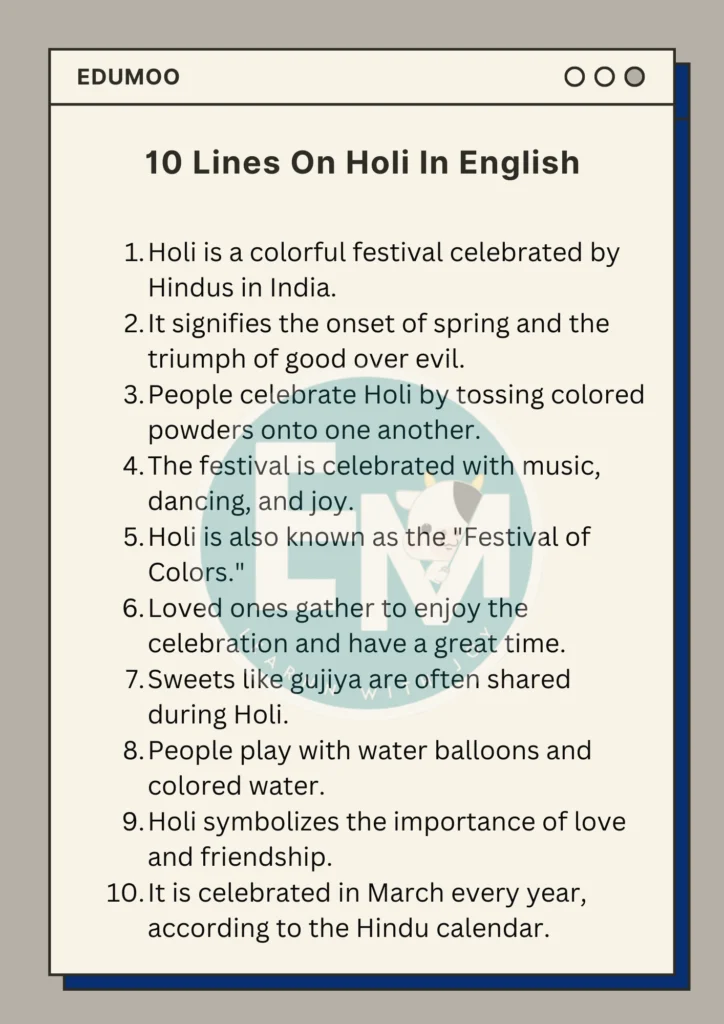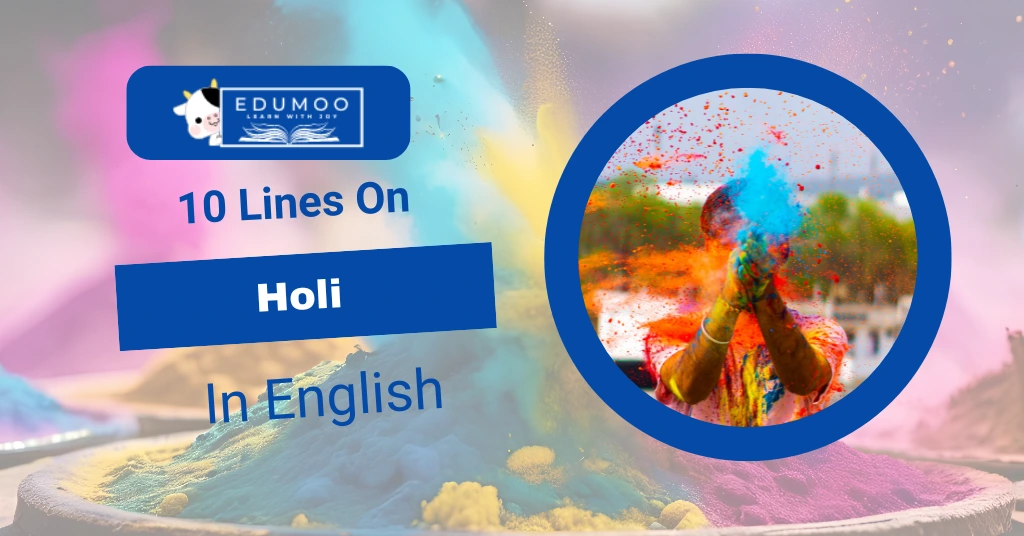Holi is one of the most exciting festivals in India, celebrated with colors, music, and dance. It signifies the onset of spring and the triumph of good over evil. People of all ages look forward to this vibrant festival, as it brings everyone together to celebrate joy and happiness. Holi is not just about colors; it also represents the bond of love, friendship, and unity among people. Let’s check 10 lines on holi in the below section.
10 Lines On Holi In English
- Holi is a colorful festival celebrated by Hindus in India.
- It signifies the onset of spring and the triumph of good over evil.
- People celebrate Holi by tossing colored powders onto one another.
- The festival is celebrated with music, dancing, and joy.
- Holi is also known as the “Festival of Colors.”
- Loved ones gather to enjoy the celebration and have a great time.
- Sweets like gujiya are often shared during Holi.
- People play with water balloons and colored water.
- Holi symbolizes the importance of love and friendship.
- It is celebrated in March every year, according to the Hindu calendar.

Essay On Holi In English In 300 Words
Holi, known as the “Festival of Colors,” is one of the most celebrated festivals in India. It marks the arrival of spring and is a time for people to come together, forget their differences, and celebrate the spirit of unity and happiness. Holi is celebrated with enthusiasm by people of all ages, who play with colored powders, water balloons, and splash each other with vibrant colors. It is a time to rejoice and share the joy with friends, family, and neighbors.
The festival is linked to several legends from Hindu mythology. One famous story is about the demon king Hiranyakashipu and his son Prahlad. Hiranyakashipu tried to kill his son, who was a devotee of Lord Vishnu, but Prahlad was saved by the blessings of Lord Vishnu. This victory of good over evil is one of the key reasons why Holi is celebrated.
During the festival, people visit each other’s homes, exchange sweets, and play with colors in the streets. The atmosphere is filled with excitement and energy, with music and dance being an essential part of the celebrations. People sing traditional songs and play drums while celebrating the festival of colors. One of the favorite sweets eaten during Holi is “gujiya,” a delicious fried pastry filled with sweet fillings.
Holi is not just about playing with colors. It is a festival that spreads happiness, fosters friendships, and encourages people to forgive and forget past conflicts. It is a time when people forget their worries and enjoy the company of their loved ones. The colors symbolize the vibrant and joyful spirit of life, and playing with them brings a sense of togetherness.
In conclusion, Holi is more than just a colorful festival; it is a symbol of love, unity, and happiness. It teaches us the importance of coming together, embracing joy, and celebrating life with a positive spirit.
Essay On Holi In English In 1100 Words
Holi is one of the most celebrated festivals in India, known for its vibrant colors, joyous spirit, and rich cultural significance. Celebrated with great enthusiasm and excitement, Holi marks the arrival of spring and is a time for people to come together, share happiness, and renew relationships. It is also a festival that symbolizes the victory of good over evil, making it not only a colorful event but also one full of meaningful traditions.
Holi is observed on the full moon day of the Hindu month Phalguna, which typically occurs in March. The festival holds great religious and cultural importance, particularly for Hindus. The festival signifies the triumph of good over evil, as well as the end of winter and the beginning of the spring season. It is a time for new beginnings, growth, and the blossoming of relationships. The colors used during Holi represent the bright colors of spring, symbolizing renewal and the energy that comes with this new season.
The most famous legend associated with Holi is the story of Prahlad and the demon king, Hiranyakashipu. According to the myth, Hiranyakashipu was a powerful king who wanted everyone to worship him, but his son, Prahlad, was a devoted follower of Lord Vishnu. The king became angry and tried to kill Prahlad many times, but each time, Prahlad was protected by Lord Vishnu. Eventually, Prahlad’s devotion triumphed, and Hiranyakashipu was defeated. This story symbolizes the victory of good over evil, which is why Holi is celebrated with such zeal.
Before the actual day of the festival, people prepare for Holi by cleaning their homes and buying colors, water balloons, and sweets. Many people also gather firewood for Holika Dahan, a ritual where a bonfire is lit on the night before Holi. This fire represents the destruction of evil, and people sing and dance around the fire to mark the occasion. This part of the celebration is based on the legend of Holika, the sister of Hiranyakashipu, who tried to harm Prahlad by sitting with him in a fire. However, Holika was burned, and Prahlad was saved by Lord Vishnu. The bonfire represents the burning away of evil and negativity.
On the day of Holi, people wake up early, dress in old clothes, and get ready to play with colors. It is a festival where everyone participates, from children to adults, and there is no limit to the fun and excitement. People often visit friends and family, applying colors on each other’s faces and sharing sweets. Water balloons and colored water are used to create a playful atmosphere, and the air is filled with laughter and happiness.
The most exciting and defining feature of Holi is the use of colors. People throw powders in various bright colors such as red, blue, yellow, green, and pink at each other. These colors are a reflection of the season of spring, which is full of blooming flowers and new life. Playing with colors brings a sense of joy and is a way for people to express their happiness. The bright colors also symbolize the spirit of togetherness, as everyone—regardless of age, gender, or social status—comes together to celebrate.
In the past, the colors used for Holi were made from natural ingredients like flowers, herbs, and spices. However, in recent times, synthetic colors have become more common. While these colors add to the vibrancy of the celebration, it is important to be cautious about using harmful chemicals. Natural and organic colors are a safer option and are kinder to the environment and the skin. Using eco-friendly colors can help preserve the spirit of Holi while also ensuring the safety and well-being of everyone involved.
Food and sweets play a big part in Holi celebrations. People prepare traditional dishes like “gujiya” (a sweet dumpling filled with coconut and dry fruits) and “mathri” (a crispy fried snack). Sweets like “barfi” and “ladoos” are also exchanged among friends and family. Many people also enjoy drinking “thandai,” a traditional drink made with milk, nuts, and spices, sometimes spiced with a bit of cannabis. The sharing of food and sweets is an important tradition, as it strengthens the bond of love and friendship among people.
Food is not just about the sweetness of the dishes but also about the warmth and togetherness that it brings. During Holi, people go door-to-door, visiting neighbors and offering sweets, further reinforcing the sense of community and camaraderie that defines the festival.
While Holi is primarily celebrated in India and Nepal, it has gained popularity in many other countries. In places with a significant Indian diaspora, such as the United States, the United Kingdom, Canada, and Australia, people celebrate Holi with great enthusiasm. It has become a global festival of joy, where people from different cultures come together to celebrate the spirit of love and unity. In fact, some cities organize large public events, complete with music, dance, and color-throwing, making it a celebration that attracts people from all walks of life.
The global reach of Holi has helped it become a symbol of unity, peace, and cultural exchange. People from different backgrounds come together to celebrate this joyful occasion, showing how festivals can transcend cultural boundaries and bring people closer.
Holi is much more than just a festival of colors. It is a time to forgive and forget past grievances, make new friends, and strengthen old bonds. It teaches us the importance of love, peace, and unity. During Holi, people forget their differences, and the world feels like a more harmonious place. The festival encourages people to be happy, to share joy, and to spread positivity, no matter what the circumstances may be.
Holi also has an environmental aspect. It marks the change of seasons, reminding us to respect nature and its cycles. The use of natural colors and eco-friendly practices can help keep the environment safe while still enjoying the festival. It is important to celebrate with respect for both nature and each other.
Holi is a festival that brings people together in a way few others can. It is a celebration of life, color, love, and the triumph of good over evil. Whether through the playful throwing of colors or the sharing of sweets, Holi reminds us of the joy of being together, regardless of our differences. The festival teaches us to forgive, to love, and to cherish the relationships we have with others. As we celebrate this festival, it’s important to remember the values it promotes—peace, unity, and happiness for all.
Conclusion
Today, we have learnt 10 lines on Holi. Holi is a festival that brings people from different backgrounds together. It teaches us to forgive and forget, making it a time to strengthen our relationships. The colorful celebrations remind us of the beauty of life and the joy of living. Holi is not just a festival; it is an expression of happiness, love, and togetherness.

